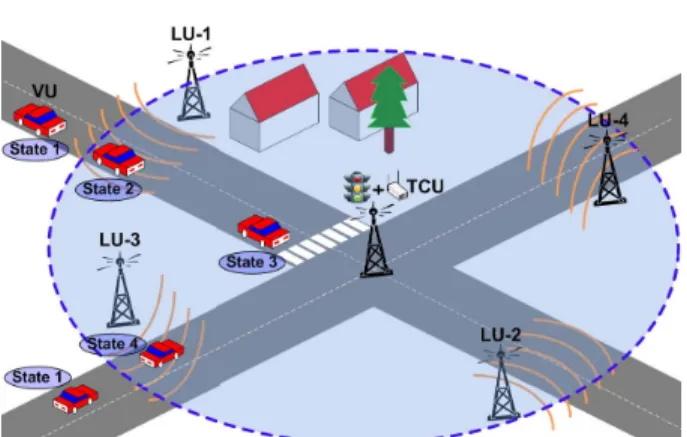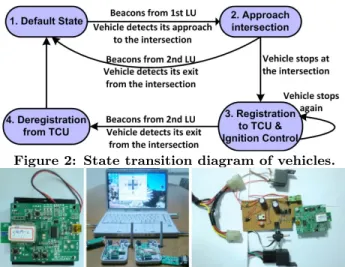Eco-Sign: A Load-Based Traffic Light Control System for
Environmental Protection with Vehicular Communications
Lien-Wu Chen
Department of Computer Science, National Chiao-Tung
University, Hsin-Chu, Taiwan
lwchen@cs.nctu.edu.tw
Pranay Sharma
Department of Computer Science, National Chiao-Tung
University, Hsin-Chu, Taiwan
pranay@cs.nctu.edu.tw
Yu-Chee Tseng
Department of Computer Science, National Chiao-Tung
University, Hsin-Chu, Taiwan
yctseng@cs.nctu.edu.tw
ABSTRACT
The Eco-Sign system is a traffic light control system for minimizing greenhouse gases emitted by idling vehicles at intersections. Eco-Sign provides the following features: (i) it can notify vehicles to turn on/off their engines based on expected waiting time for green lights at intersections, (ii) it can dynamically adjust traffic light timing to minimize the number of vehicles stopping at an intersection based on vehicle arrival and departure rates, and (iii) it is a fully dis-tributed system in the sense that each intersection can learn its local traffic condition and optimize its traffic sign setting to prevent congestions and thus traffic jams. Eco-Sign thus demonstrates a new traffic light control system for environ-mental protection.
Categories and Subject Descriptors: C.2.1 [Network
Architecture and Design]: Network communications
General Terms: Algorithms, Design, Management Keywords: Dynamic Traffic Light Control, Environmental
Protection, Ignition Control, Vehicular Communications
1.
INTRODUCTION
Traffic congestion in modern cities seriously affects the living quality and environments. Vehicles on the roads pro-duce mass air pollution that emits greenhouse gases such as carbon dioxide, hydrocarbons, and nitrogen oxides. Idling vehicles caused by traffic jams and red lights at intersec-tions waste a large amount of fuel and seriously pollute the air. Studies show that the ratio of man-made dioxide emis-sions from transportation systems is about 30% [1]. Efforts have been made to increase the traffic flows in urban arterial roads [2], to reduce the waiting time at intersections [3], and to navigate vehicles in congested roads [4].
In this paper, we propose a load-based traffic light con-trol system called Eco-Sign, which can help determine the timing of engine ignition at intersections and thus minimize greenhouse gases emitted by idling vehicles at intersections. At an intersection, a localization unit (LU) is placed on each road segment before the intersection to help vehicles know where they are. In addition, a traffic control unit (TCU) is connected to traffic lights to control their timing. Each vehicle equips with a vehicle unit (VU) to receive from LU the IDs of its road segment and TCU. It then controls its engine ignition based on the traffic light timing from TCU.
Copyright is held by the author/owner(s).
SIGCOMM’11, August 15–19, 2011, Toronto, Ontario, Canada.
ACM 978-1-4503-0797-0/11/08.
Figure 1: System architecture of Eco-Sign.
In Eco-Sign, a vehicle can get the intersection information from the first passed LU and register itself to TCU as stop-ing at the intersection. Durstop-ing the registration process, the vehicle will receive the traffic light timing from TCU and its onboard VU can automatically turn off its engine as the re-maining waiting time is larger than or equal to a predefined time threshold α. If the engine is turned off by VU, it will be automatically turned on to pass the intersection at the next green light as the remaining waiting time is smaller than or equal to another time threshold β. As passing the second LU at the intersection, VU will deregister itself from TCU. According to vehicle registration and deregistration frequen-cies, TCU can estimate vehicle arrival and departure rates to achieve dynamic traffic light control.
Eco-Sign can thus help turn on/off engines of vehicles to reduce air pollution as they are waiting at intersections. On the other hand, TCU can dynamically adjust the traffic light timing to minimize the number of vehicles stopping at an intersection based on the observed vehicle arrival and de-parture rates. It is a fully distributed system in that each intersection can learn its local traffic condition and optimize the traffic sign setting to prevent road congestions. Eco-Sign thus demonstrates a new traffic light control system for environmental protection.
2.
SYSTEM DESIGN
Fig. 1 shows the system architecture and vehicles’ states at different locations nearby an intersection. On the inter-section side, it consists of a LU on each road segment, which provides the location information to vehicles, and a TCU, which decides and transmits the traffic light timing. On the vehicle side, a VU is equipped onboard to receive the traf-fic light timing from TCU and control the engine ignition timing.
Figure 2: State transition diagram of vehicles.
Figure 3: Eco-Sign hardware components.
VU consists of a network interface, an On Board Diag-nostics (OBD) interface [5], an ignition control circuit, and a microprocessor. The network interface is to communicate with LU and TCU. The OBD interface is to capture the cur-rent vehicle status. The ignition control circuit is responsible for turning on/off the engine at intersections as its speed is 0 (Alternatively, this can serve as a recommendation ser-vice only.). The microprocessor collects information from all other components and issues commands to them. LU is equipped with a directional antenna and is placed at a road segment with a certain distance from the intersection. It periodically broadcasts location beacons on a dedicated channel, which contain IDs of the road segment and TCU, to vehicles entering or exiting the intersection. TCU con-sists of a microprocessor and two omnidirectional antennas operating in distinct channels, one for vehicle registration and the other for deregistration.
Fig. 2 shows the state transition diagram of vehicles. Ini-tially, a vehicle is in state 1 (Default State). When the vehicle approaches an intersection, it will receive beacons from the first passed LU and then enter state 2 (Approach Intersection). If it passes the intersection without stopping, it will receive beacons from the second passed LU and then switch back to state 1. On the contrary, if it stops at the intersection due to red lights, it will enter state 3 (Regis-tration to TCU & Ignition Control), register itself to TCU, and decide if its engine should be turned off. Note that if it stops at the intersection more than once, it will register itself again and turn off its engine for each stop. When it exits the intersection, it will receive beacons from the sec-ond passed LU and then enter state 4 (Deregistration from TCU). After it deregisters itself from TCU, it will go back to state 1.
3.
PROTOTYPE IMPLEMENTATION
We have developed a prototype of Eco-Sign. The micro-processor and network interface used in VU, LU, and TCU is Jennic JN5139 [6], which has a 16MIPs 32-bit RISC proces-sor, a 2.4GHz IEEE 802.15.4-compliant transceiver, 192kB of ROM, and 96kB of RAM. As shown in Fig. 3(a), LU is implemented by JN5139 development board powered by four AA batteries. TCU is implemented by integrating two JN5139 development boards connected with a notebook via USB ports, which is running on Windows XP operating sys-tem, as shown in Fig. 3(b).
Figure 4: Prototype demonstration.
VU is implemented by JN5139 development board inte-grated with the ignition control circuit, as shown in Fig. 3(c). The interfacing circuit for ignition control is using ULN2003 [7] Darlington transistor arrays, which takes the signal from Jennic I/O pins and controls 12 V, 40 A automotive relays. A Y-type connector is provided to avoid cutting the original wires inside the car. The power of VU is supplied by the 12 V in-vehicle battery.
Fig. 4 shows the prototype demonstration of Eco-Sign. TCU and LU are installed at the intersection and the road-side lamppost on each direction leading to the intersection, as shown in Fig. 4(a) and Fig. 4(b), respectively. They are operating on 3 different channels. VU is set up in Maruti Suzuki 800 [8], as shown in Fig. 4(c). On one hand, the ve-hicle is driven from each road segment of the intersection to register/deregister itself to/from TCU. On the other hand, the traffic light timing is varied in road segments of the inter-section and the vehicle can receive the correct timing value from TCU. In addition, automatic ignition control is acti-vated as the vehicle speed is 0 km/hr and the remaining waiting time is larger than 30 seconds.
For indoor demonstration, we use a projector to simulate traffic conditions on road segments at an intersection, as shown in Fig. 4(d). A remote control car with VU is used to approach the intersection and trigger operations of Eco-Sign. Fig. 4(e) shows the car status including motion status, approaching side, remaining waiting time, and ignition ad-vice.
4.
ACKNOWLEDGMENTS
Y.-C. Tseng’s research is co-sponsored by MoE ATU Plan, by NSC grants, 97-3114-E-009-001, 97-2221-E-009-142-MY3, 98-2219-E-009-019, 98-2219-E-009-005, and 99-2218-E-009-005, by ITRI, Taiwan, by III, Taiwan, by D-Link, and by Intel.
5.
REFERENCES
[1] eSafety Forum. ICT for Clean and Efficient Mobility. Working Group Final Report, Nov. 2008.
[2] Y. Li, W. Wei, and S. Chen. Optimal Traffic Signal Control for an Urban Arterial Road. In 2nd Int’l Symp. on Intelligence Information Technology Application, pages 570-574, Dec. 2008. [3] E. Azimirad, N. Pariz, and M.B.N. Sistani. A Novel Fuzzy
Model and Control of Single Intersection at Urban Traffic Network. IEEE Systems Journal, 4(1):107-111, Mar. 2010. [4] V. Verroios, K. Kollias, P. K. Chrysanthis, and A. Delis.
Adaptive Navigation of Vehicles in Congested Road Networks. In 5th Int’l Conf. on Pervasive Services, pages 47-56, July 2008. [5] On Board Diagnostics. http://www.obdii.com/background.html. [6] Jennic, JN5139. http://www.jennic.com.
[7] ULN2003, High Voltage and Current Darlington Transistor Array. http://www.datasheetcatalog.org/datasheets/120/489337 DS.pdf [8] Maruti Suzuki 800. http://www.maruti800.com/.

